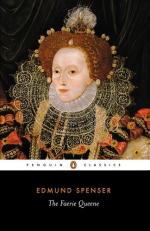CANTO IV
I. The Plot: In this and the following canto the adventures of the Redcross Knight are continued from Canto II. Guided by Duessa, he enters the House of Pride. There he sees Lucifera, the Queen of Pride, attended by her sinful court. Her six Counselors are described in detail, with an account of a pleasure trip taken by the Queen and her court. Sansjoy unexpectedly arrives and challenges the Knight to mortal combat for the shield of Sansfoy. That night Duessa holds a secret conference with the Saracen knight.
II. The Allegory: 1. The Christian Soldier, under the influence of false ideals (Duessa), is exposed to the temptations of the Seven Deadly Sins, chief among which is Pride. In the midst of these sinful pleasures, he is assailed by Joylessness, on whose side is Falsehood secretly.
2. The religious and political allegory is here vague and somewhat discontinuous. There is a hint, however, of the attempts of Mary Queen of Scots to bring England back to Romanism. The pride and corruption of the false church and its clergy are set forth. There is also a suggestion of the perilous position of the English in Ireland.
20. OF EACH DEGREE AND PLACE, of every rank and order of society.
21. HAVING SCAPED HARD, having escaped with difficulty.
24. LAZARS. Leprosy was a common disease in England even as late as the sixteenth century.
49. MALVENU, ill-come, as opposed to Bienvenu, welcome.
73. LIKE PHOEBUS FAIREST CHILDE, Phaethon, the son of Helios. He was killed by a thunderbolt from the hand of Zeus, as a result of his reckless driving of the chariot of the sun.
86. A DREADFULL DRAGON, Fallen Pride.
94. This genealogy of Pride is invented by the poet in accord with the Christian doctrine concerning this sin.
107. SIX WIZARDS OLD, the remaining six of the Seven Deadly Sins, Wrath, Envy, Lechery, Gluttony, Avarice, and Idleness. See Chaucer’s Parson’s Tale for a sermon on these mortal sins, Gower’s Dance of the Seven Deadly Sins, and Laugland’s Piers Plowman.
145. COCHE. Spenser imitates Ovid and Homer in this description of Juno’s chariot. The peacock was sacred to the goddess, who transferred to its tail the hundred eyes of the monster Argus. See Ovid’s Metamorphoses, i, 625 seq.
157. WITH LIKE CONDITIONS, etc. The behests were of a kind similar to the nature of the six Sins.
174. HE CHALENGED ESSOYNE, he claimed exemption.
185. LIKE A CRANE. This refers to Aristotle’s story of a man who wished that his neck were as long as a crane’s, that he might the longer enjoy the swallowing of his food. Nic. Ethics, iii, 13.
205. A DRY DROPSIE, a dropsy causing thirst.
236. UPON A CAMELL, etc. The reference is to a story in Herodotus’ History (iii, 102 seq.), in which the Indians are described as carrying off on camels gold dust hoarded by enormous ants.




